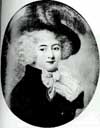


Thérésia de Cabarrus, born in 1773, was the daughter of a Spanish banker. At 15 she married the Marquis de Fontenay and was presented at the court of Louis XV. In the 1780s she began to take an interest in liberal politics, and when her husband fled at the outbreak of the French Revolution in 1789 she resumed her maiden name, spoke before the Convention and obtained a divorce in 1791. Three years later she took refuge in Bordeaux and although arrested as the former wife of an emigré aristocrat, she ingratiated herself with the Commissary of the Convention, Tallien, became his mistress and through her influence obtained the release of many prisoners. She accompanied him when he was recalled to Paris, only to be imprisoned on Robespierre's orders first in La Force, then Carmes where she met Josephine De Beauharnais. Tallien joined the conspiracy to oust Robespierre and in 1795 Thérésia was released and acclaimed as "Notre Dame de Thermidor", or "Our Lady of Thermidor". The couple were married, but divorced in 1802.
Her salon became the centre of Directoire society. Tallien's power waned and after a brief flirtation with Napoleon she moved first to the powerful Barras, then to the millionaire-speculator Ouvrard and finally, attempting to gain respectability she married the Comte de Caraman in 1805. The death of his father (allegedly from rage at the match) elevated her quickly to Princesse de Chimay, and she spent the rest of her life on their estates, which became part of Holland after the Battle of Waterloo. She bore ten children during her various liaisons. She died in 1835.
Speaking of Madame Tallien in her memoirs, the Duchess of Abrantes recalled her animated and charming beauty, the airs which joins together French promptness and Spanish pleasure.



